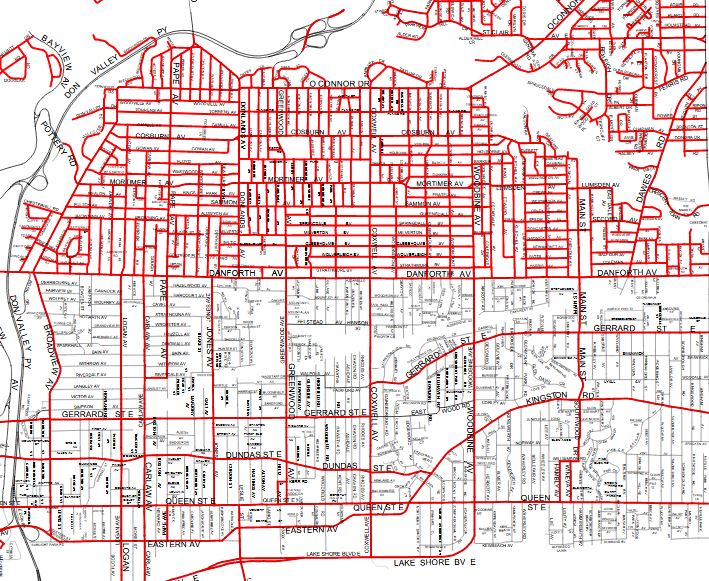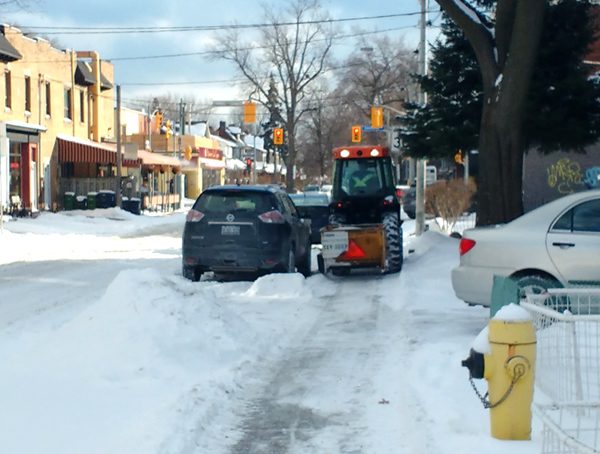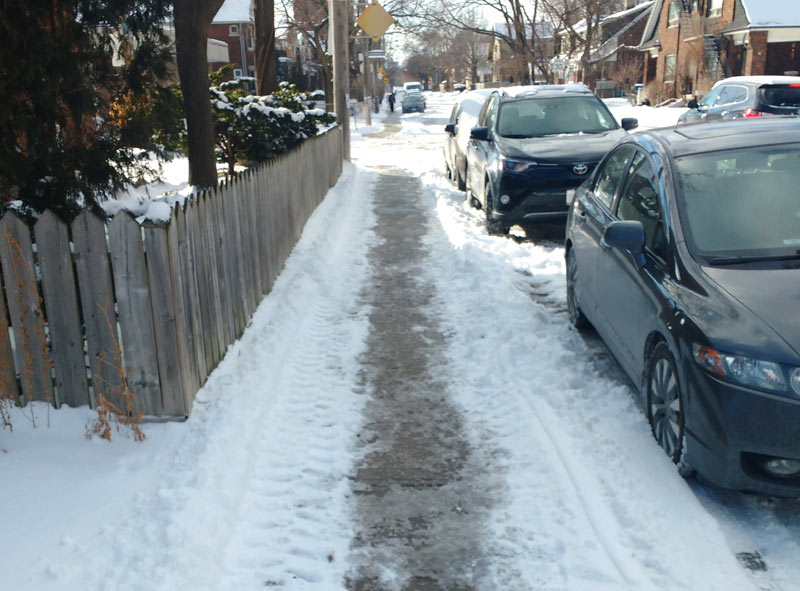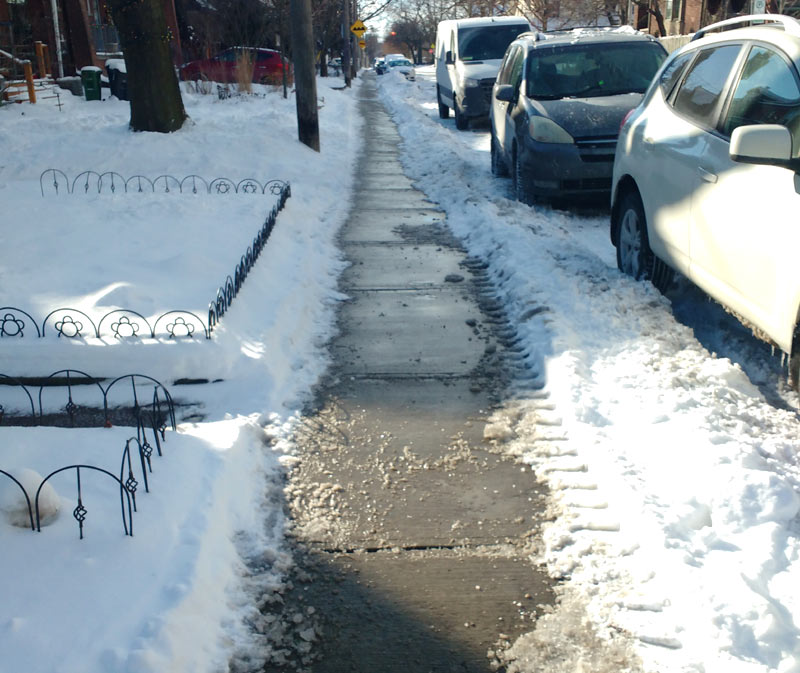The City of Toronto plows snow from local sidewalks in most of the city, but not in a “no-plow” zone that encompasses the oldest and most densely populated parts of the city. In these areas, the City now plows main street sidewalks, but not local/residential street sidewalks (instead property owners are required to shovel snow themselves, although this is rarely enforced). It’s a gap that creates significant problems (PDF) for safety and accessibility for pedestrians, especially seniors and those with disabilities, and, as a recent Toronto Public Health report detailed (PDF), results in many injuries from slips and falls — and resulting costs to the City from insurance claims.
So Mayor John Tory’s recent letter to the City of Toronto’s General Manager of Transportation Services, Barbara Gray, asking staff to figure out how the City can start plowing the 1,100 km of sidewalks (PDF) that don’t currently enjoy this service, is welcome.
The last time City Council asked for a review of this service, Transportation Services came back with the argument that they couldn’t plow these sidewalks mechanically, and made the claim that they would need to clear it all by hand, requiring 360 gangs of day labourers at at cost of $9.900,000 a year (PDF, p. 5).
The reasons (PDF, p. 6) Transportation Services gives for saying they can’t clear these sidewalks mechanically boil down to the following:
- The sidewalks are too narrow
- There’s nowhere to dump the snow (the sidewalks are “monolithic”, an impressive sounding word meaning there’s no boulevard space between the sidewalk and the road. Related complaints include there are parked cars, and/or the road is too narrow)
- There are too many obstacles – both City obstacles, such as utility poles, and private obstacles such as fences, which could get damaged.
The thing is, though, there are already sidewalks with pretty much the same conditions that the City successfully plows. Not long ago, the City extended plowing to all the areas north of the Danforth. Before amalgamation, East York plowed its sidewalks, but Toronto didn’t, leaving the strange situation where one street was plowed but the next street over was not. After the cities were amalgamated, the City eventually extended plowing all the way to the northern edge of the Danforth.

These new streets are pretty much identical to the streets south of the Danforth that the City claims it cannot plow. The sidewalks are narrow, there’s no boulevard, there’s fences and parked cars. Yet the City plows them successfully. Here are examples (Strathmore Ave.), where you can see the plow’s treadmarks.
If the City can plow these sidewalks, it can plow most of the local sidewalks in the old city. It might take a few years to work through solutions to some of the trickier areas, but it’s time to get started. Where the sidewalk is truly blocked, that means it’s too narrow for accessibility standards, so we should be fixing that problem anyway — solving two problems at once. Last time, City staff were simply responding to councillors and citizens; now that the Mayor himself is behind the call, perhaps staff will be more creative and responsive in their assessment.
One comment sometimes heard from people whose sidewalks the City does plow is that they are often plowed late, so that there is still a layer of packed snow or ice left behind. The solution to that issue is for the plows to also spread an ice melter behind the plow (you can see the salt supply behind the plow in the top image, and the effect of the salt creating a bare surface in the other images). While salt is the melter most commonly used, it has many disadvantages (toxic to nearby plants and to rivers, corrosive of clothing, painful for dogs). The City could overcome these disadvantages by instead using beet juice compound on sidewalks (which it already uses sometimes on roads) — which not only is far less toxic, but is also more effective at lower temperatures. It is somewhat more expensive, but sidewalks are a limited surface area so the cost would be contained (other cities suggest using beet juice compounds saves money in the long run).
Expanding sidewalk snow plowing to cover the entire city would cost money, but nowhere near $10 million. Some of that money would be recouped in reduced insurance payouts, and the safety, accessibility and quality of life benefits would be significant. It’s feasible to harmonize sidewalk snow plowing service across the city, and the time has come to do so.






12 comments
I grew up in the 905 suburbs where the City does not plow your sidewalk and no one has ever heard of windrow clearing. I’m constantly baffled by the bickering and whining about snow removal in the amalgamated City. Suck it up, get off your phone, pick up a shovel, and clear the damn snow in front of your property.
Toronto is a walkable city. Unless it snows in the old part of city.
While the 905 may have boulevards where the snow windrows can be dumped, the old city was created before the invention of the automobile, so there are no boulevards to dump the snow. The windrows end up on the sidewalks, so need to be pushed aside by sidewalk snowplows.
I’m from Saskatoon but I’m living in old Toronto now, I couldn’t believe how infrequently people actually shovel sidewalks here… It was even a big thing to get Metro to shovel there’s. So few of the condo buildings do.
Meanwhile in Saskatoon is pretty rare that a sidewalk isn’t shoveled.
Our tax dollars as Torontonians should be going to essential services and infrastructure upgrades we can’t easily do ourselves. Snow clearing is a part of responsible home ownership, and part of being Canadian. If you can’t do it yourself, ask a neighbour to help, pay a local kid 5$ to do it, or move to a place which better suits your lifestyle needs.
When the city does a terrible job clearing the sidewalk, as it often does, many of the homeowners in the area feel no responsibility to finish the job, leaving, as mentioned above, packed snow or sheer ice. At least in the old, unplowed, Toronto, 311 can be called on the people who don’t shovel and should. And I’ve seen the results of doing so.
The sidewalk plow runs on my front lawn, so I have to clear the snow before they come. On top of that, what happens if the snow gets pushed and damage the cars parking on the street? It is the law, and we need to hold people accountable to clear the sidewalk in front of their property… ticket them! For those who can’t do it, the city does have services to help out those cases.
Go to Montreal if you want to see how it’s done.
90% of the time I shovel the sidewalk in front of my house it’s to guide the snow plow away from my lawn.
21 years later and still not fully amalgamated.
“…pay a local kid 5$ to do it,….”
Good luck with that!
Great article. Total agreement here!
To the commenters here saying do it yourself: the problem is that if one household doesn’t do it (or more likely 10% – 40% of households in some downtown neighbourhoods) then that renders the sidewalk impassable for people with mobility issues and it takes 3 weeks for the City to investigate. Further, the City of Toronto is still on the hook according to a 2000 Ontario Court of Appeals decision and ends up paying out about $6.7 million in liability a year because of falls caused by snow and ice. Last, it’s also an issue of equity. Tax rates are the same across the City, so why should downtown – where there are far more people who walk – not receive those services? This presentation by the Harbord Village Residents’ Association to the Budget Committee last week has 10 great arguments for clearing sidewalks downtown: https://www.toronto.ca/legdocs/mmis/2019/bv/comm/communicationfile-89305.pdf